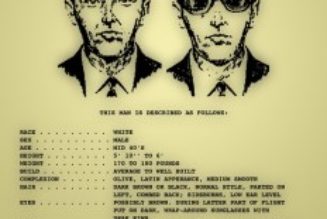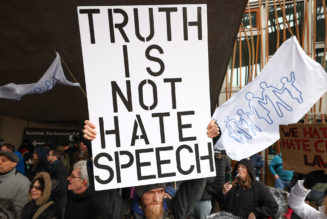
St. Patrick died during Lent. Which year isn’t certain. But for one of the leading candidates (A.D. 461), March 17 was a Friday.
And while Easter is a moveable feast, St. Patrick’s Day is always during Lent — and sometimes on a Friday. Like this year, for instance.
That means trouble — for Friday is also a day of abstinence for Catholics, especially during Lent.
Something’s got to give.
“You cannot feast and fast at the same time,” noted C.J. Doyle, executive director of the Catholic Action League of Massachusetts, who supports St. Patrick’s Day dispensations from the obligation of abstinence.
Since Aug. 15, 1790, when John Carroll lay prostrate on the floor of a castle chapel in Dorset, England, and was ordained America’s first Roman Catholic bishop, St. Patrick’s Day has fallen on a Friday 32 times.
(If you must know, the years are 1797, 1809, 1815, 1820, 1826, 1837, 1843, 1848, 1854, 1865, 1871, 1876, 1882, 1893, 1899, 1905, 1911, 1916, 1922, 1933, 1939, 1944, 1950, 1961, 1967, 1972, 1978, 1989, 1995, 2000, 2006 and 2017.)
This year — 2023 — is the 33rd.
That works out to an average of once every 6.85 years.
Many of those times, it has led to this question for the local bishop: Will he or won’t he grant a dispensation?
Yes, No, Maybe So
Over the course of about a week in late February, the Register sought answers to that question from all 176 Latin Rite territorial Catholic dioceses in America, either through published statements or requests for comment. Responses were still trickling in as this edition of the newspaper went to press. (You can see updates at NCRegister.com.)
More than three-quarters of the country’s diocesan bishops — 137 — had answered the question by deadline. Of those, 105 are offering some relief for St. Patrick’s Day: 80 have said yes to a dispensation; 25 are offering a “commutation,” requiring Catholics in their diocese to substitute some other penance if they plan to eat meat on Friday, March 17; and 32 have said No.
The Latin Rite Catholic Church requires fasting (defined as one full meal and up to two smaller ones combining for less than a full meal) and abstinence (not eating meat) on Ash Wednesday and Good Friday. In the United States, each of the six Fridays during Lent is also a day of abstaining from meat.
It’s not a question when March 19 falls on a Friday, because that’s St. Joseph’s Day, a solemnity on the universal Church calendar, when fasting and abstinence are not required. Yet St. Patrick’s Day — though a solemnity in some places — is only an optional memorial on the universal Church calendar, meaning it doesn’t command an automatic dispensation from the rules of Lent.
Even so, canon law gives diocesan bishops authority “to dispense the faithful” from many disciplinary laws of the Church, including most fast days.
Why Friday?
In the early Church — some say the first century — Christians fasted and abstained from certain foods on Friday because that’s the day Jesus died.
So they have ever since. It’s a surprise to many Catholics, but canon law still calls for “Abstinence from meat, or from some other food as determined by the Episcopal Conference, to be observed on all Fridays.”
Yet canon law also allows national bishops’ conferences to make their own rules on fasting and abstinence — “determine more precisely the observance,” in the precise wording. With two exceptions (Ash Wednesday and Good Friday), a bishops’ conference can decide on how and whether to apply the ordinary rules.
Those now in their mid-60s and older who were born into Catholic families remember when eating meat on Fridays was prohibited almost every Friday of the year. In 1966, what was then called the National Conference of Catholic Bishops issued new regulations allowing Catholics to eat meat on Fridays except for Lent and Good Friday. The regulations, which remain in place, added a “hope that the Catholic community will ordinarily continue to abstain from meat by free choice” on other Fridays, “as formerly we did in obedience to Church law.”
What the Bishops Are Saying
The Yeses to the St. Patrick’s Day dispensations in 2023 can be broken down into simple dispensations and those that come with requests to practicing Catholics — typical verbs are “exhorted” and “urged” — to do something else in lieu of abstaining from meat. Examples include praying the Rosary, giving to the poor or not eating meat on a non-Friday during Lent.
Some of the “simple” Yeses are expansive. In New Hampshire, Bishop Peter Libasci’s statement offers a rousing recitation of “the crushing oppression of the Irish potato famine” of the 1840s and Irish Catholics’ overcoming “oppression, prejudice, suspicion, and an evil animosity” before declaring: “With all of this in mind, I, as Bishop of the Diocese of Manchester, grant to all Catholic men and women, boys and girls of the Diocese of Manchester and all visitors as well, a dispensation from Abstinence from Meat on Friday, March 17, 2023.”
Of the commutations (“Yes, but …”), among the more creative is the one provided by Bishop Earl Fernandes, who offers Catholics in the Diocese of Columbus in central and southern Ohio five options, including visiting a church in the diocese named St. Patrick; going to Mass on March 17; or saying a prayer called “St. Patrick’s Breastplate,” which goes back at least to the eighth century (if not to St. Patrick himself) and has strong connections with Celtic spirituality, including an emphasis on God working through the physical elements.
Bishop Kevin Rhoades says Catholics eating meat on March 17 in his Diocese of Fort Wayne-South Bend in Indiana should substitute for it by attending Mass that day, saying the Rosary for peace in the world, or spending a half-hour in prayer before the Blessed Sacrament.
“The commutation is meant to preserve the penitential spirit of a Lenten Friday while also allowing for the celebration of a great saint whose feast should be celebrated in a spiritual manner and not merely in a secular context,” Bishop Rhoades wrote.
Even some of the Nos come with back doors. In some dioceses, including the Archdiocese of Cincinnati, the Diocese of Marquette, Michigan, and the Diocese of Richmond, Virginia, bishops are emphasizing that people who want a dispensation can ask their pastor for one. Others, including the Diocese of Lansing, Michigan, and the Diocese of Wichita, Kansas, are making a point of mentioning that people who belong to parishes named St. Patrick are allowed to eat meat because for them it is a solemnity. In the Diocese of Sioux Falls in eastern South Dakota, a dispensation is available only for “those who participate in an event remembering St. Patrick where meat is served” and undertake “another form of penance.”
Bishop Thomas Tobin in Rhode Island isn’t issuing a general dispensation, but he will entertain requests in writing to the diocese’s vice chancellor through U.S. mail (One Cathedral Square, Providence, R.I. 02903).
“Bishop Tobin will grant the dispensations upon request,” a spokesman told the Register by email. “His Excellency believes it is important to remind the faithful of the seriousness of the Lenten disciplines. The requests also create the opportunity to remind the faithful that any dispensation of abstinence from meat should be substituted with another suitable penance, work of charity, or prayer.”
A Lot of People Care
This matter certainly causes a stir. Several of the bishops’ decrees on the subject use the word “many” — as in many people are asking the bishop about it. Diocesan officials contacted expressed curiosity about what other dioceses are doing, and an unusual number asked to be sent this story when published.
A review of published articles around the time of past Friday, March 17 shows that the issue was a matter of concern years ago, as well, meriting in some cases multiple-day coverage from major metropolitan newspapers.
In 1883, Archbishop John Williams seemed to have solved the problem for the very-Irish Archdiocese of Boston, when he got Pope Leo XIII to declare St. Patrick’s Day a “Double of the First Class” feast, which in the Tridentine Church calendar of the time put it in the class of the highest liturgical occasions (like St. Joseph’s Day), on which there is no fasting or abstinence.
The Tridentine calendar went away when Pope St. John XXIII reformed the Church calendar in 1960. St. Patrick’s Day is now a feast day in the archdiocese, but triggers no automatic dispensation.
Lack of a dispensation causes angst in some places. In Illinois, the Diocese of Springfield’s magazine Catholic Times published a letter recently from a woman frustrated with the local bishop.
“… I assume Bishop Thomas John Paprocki will not give us permission to enjoy corned beef in our Irish celebrations. Would it be a mortal sin to travel to a nearby diocese where their bishop grants a dispensation, allowing Catholics to enjoy their corned beef that day?” she wrote.
A priest who is a pastor and diocesan official responded that “one could make an argument” that it is sinful to do as she suggests, and moreover that it’s not necessary, because she could ask her pastor for a dispensation.
As for why the bishop isn’t issuing a general dispensation, Father Christopher House wrote:
“Granting a dispensation from an ecclesiastical law is seen as a ‘wounding’ of the law so there needs to be a proportional reason for doing so, especially such a broad action as dispending an entire diocese. If we were the Archdiocese of Boston, filled with Irish Catholics, there would be greater reason to justify the dispensation, but that is not so much the case here.”
He added: “Whatever we choose to do or not do in honor of St. Patrick’s Day, I would encourage all of us to remember the man himself. History tells us that Patrick was devout, very determined, and rather austere. Let us ask the great Apostle of Ireland to pray for us that, like him, we might seek to bind ourselves to the Blessed Trinity in all that we do.”
Why St. Patrick?
Patricius, as he is known in Latin, was born in the fifth century in a village no one can identify today but that is usually associated with the coast of what is now northern England or southern Scotland.
Though raised Catholic, he was a nonbeliever as a teenager. At 16, he was kidnapped by raiders and sold into slavery in Ireland. While working as a shepherd, exposed to the elements, he came to know God, as he relates in his autobiographical spiritual treatise Confessio. He ran away, made it home to Britain, and then later obeyed a vision in a dream by returning to Ireland as a missionary bishop. His success was extraordinary and helps explain why no ethnic group has as much fervor about its national saint as the Irish do about St. Patrick.
“The Irish devotion to their patron saint is readily understandable,” said Doyle, of the Catholic Action League of Massachusetts, by email. “In the annals of Latin Christendom, the Apostle of Ireland is unique. An entire nation and its vast diaspora of descendants can trace their Catholic faith and culture — and their prospects for eternal salvation — to the evangelism of a single saint. Our debt of gratitude to St. Patrick is beyond measure.”
Why St. Patrick’s Day?
In medieval through early modern times, Catholics in Ireland were the hardest fasters in Europe, holding on to some of the Church’s more ambitious rules long after Rome had rescinded them, according to food scholar Marjorie Deleuze, who wrote about Irish fasting in a 2018 academic article in the Canadian Journal of Irish Studies. Into the 20th century, rural Catholics in Ireland told later interviewers, people still abstained throughout Lent from meat, eggs, butter and milk in tea.
Their one exception was St. Patrick’s Day, a mid-Lent break they looked forward to and reveled in.
It’s that reveling that supporters of allowing meat that day relish.
“Some bishops have already allowed a dispensation from the Friday Lenten stricture on abstaining from eating meat, and I expect many more will do so. They all should,” said Bill Donohue, president of the Catholic League for Religious and Civil Rights, by email.
Why?
“The most cardinal of the cardinal virtues is prudence, and prudence dictates that Catholics — of all races and ethnicities — should be permitted to enjoy corned beef on St. Patrick’s Day,” Donohue said. “The idea of not having corned beef on St. Patrick’s Day is about as sacrilegious as not having beer. Cheers everyone!”
Why Meat?
Critics of the St. Patrick’s Day dispensations say there’s much ado about corned beef, which they say doesn’t merit the kind of consideration it gets.
Corned beef and cabbage is the most popular meal among Irish-Americans celebrating the occasion. (The “corn” in corned beef refers to the size of the grains of salt used to preserve it starting around the 17th century, about the size of a kernel of corn.)
Eating corned beef is American Irish, not Ireland Irish. It’s not the tradition in Ireland, where corned beef under English rule was plentiful but largely unavailable because it was expensive and almost exclusively exported. Yet when Irish immigrants fleeing hunger and poverty started showing up in large numbers in the United States during the 1830s, 1840s and 1850s, corned beef was the cheapest meat available in this country and became a treasured (if not always frequent) part of their diet.
It has been popular among Irish-Americans ever since, particularly on March 17.
“It brings us back to 1836, when we were founded, and we were eating corned beef because nobody else wanted it,” said Daniel O’Connell, national president of the Ancient Order of Hibernians, in a telephone interview. “It might not have been the best meal in the world, but the Irish talked about it like it was filet mignon.”
But why is it important to eat it now, on St. Patrick’s Day, even when it’s a Friday during Lent?
It’s not essential, O’Connell said — you could eat fish on St. Patrick’s Day — but going without it wouldn’t be the same, and for him it even has a religious connection.
“Being able to eat the traditional meal that our ancestors ate really takes us back to our Ireland,” O’Connell said. “And so the corned beef — it’s not an Irish meal; it’s an Irish-American meal — but it’s us holding onto our ancestors, who brought very strong Catholicism to the United States.”
St. Patrick and the U.S. Catholic Church
The Irish were the first large Catholic immigrant group in America. In time, they dominated Boston and New York. But some spread out across the country.
Five current cathedrals in the United States are named after St. Patrick (New York, New York; Norwich, Connecticut; Harrisburg, Pennsylvania; El Paso, Texas; Fort Worth, Texas). So is a co-cathedral (sharing top billing), in Billings, Montana.
It’s also the name of a former cathedral still standing (New York City) and a former cathedral that isn’t (Rochester, New York). It is the name of the pro-cathedral (meaning temporary) of three more dioceses (Columbus, Ohio; New Orleans, Louisiana; and Newark, New Jersey). It was the proto-cathedral (meaning original) of another (San Jose, California). It was even the name of the cathedral of two dioceses that don’t exist anymore (Grass Valley, California; Lead, South Dakota).
There have been 26 diocesan bishops in the United States with the first name Patrick. At least 26 have had Patrick as a middle name.
Boston’s Cardinal Seán Patrick O’Malley has a foot in both camps. His birth name is Patrick; it became his middle name when he took Seán (an Irish form of John) as his religious name when he joined the Capuchin Franciscans.
Cardinal O’Malley has also been on both sides of the St. Patrick’s Day dispensation. As archbishop of Boston, where the patron saint is St. Patrick, he gave a dispensation in 2006 and 2017, and he is giving one this year.
In 2000, when he was bishop of Fall River, Massachusetts, then-Bishop O’Malley caught headlines and heartache when he initially declined to give one. He eventually reversed course and issued a dispensation, saying that the diocese’s previous policy of granting dispensations to people who asked for them was confusing — but not without lamenting in the diocesan newspaper The Anchor the diminishing connection between Catholics and fasting.
A St. Patrick’s Day dispensation made sense, he said, when he was growing up during the 1940s and 1950s, when Lent was “a true desert experience” and when the Church prescribed, in his estimate, almost 100 days a year of either fasting or abstaining from meat. Since 1966, though, abstinence days are down to eight — Ash Wednesday, Good Friday and the six Fridays of Lent. Fasting days are down to two — Ash Wednesday and Good Friday.
“At this point in our history, I no longer consider a dispensation from fasting or abstinence a logical imperative …” Bishop O’Malley wrote.
The future cardinal also touched on another sore spot for religious people who celebrate the day: the tendency for March 17 to become less about religion or even Ireland and more like carnival.
St. Patrick’s Day has long been associated with drinking — an Irish ditty from years gone by praises the 16th-century Council of Trent for requiring fasting from, in the local accent, “mate and not upon drink.” But some have expressed dismay with the apparently increasing trend of getting blotto that day, something Bishop O’Malley addressed two decades ago.
“Another concern to me, on this festive day, is liquid refreshment,” he wrote at the time. “I would urge all to be temperate in drinking. The legacy of Patrick is one of faith in Christ and fidelity to His Church. Excessive drinking should have no part in celebrations that honor this man of faith. We want everyone to have a good time and be good.”









